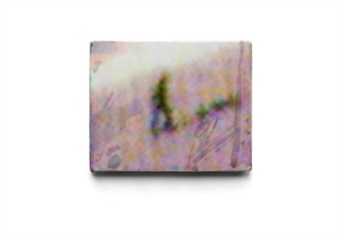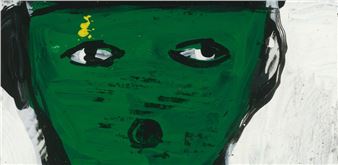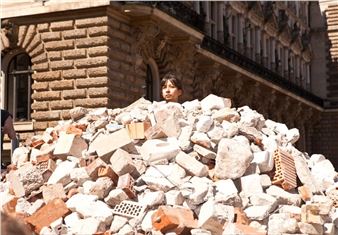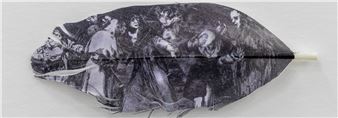Project a Black Planet: The Art and Culture of Panafrica
Curated by MACBA director Elvira Dyangani Ose, along with Antawan Byrd, Adom Getachew and Matthew S. Witkovsky, Project a Black Planet: The Art and Culture of Panafrica is the first major international exhibition to examine the cultural manifestations of Pan-Africanism from the 1920s to the present.
It is a project developed jointly with the Art Institute of Chicago, the Barbican Centre in London and the KANAL–Centre Pompidou in Brussels. This collaboration has made the magnitude of the exhibition possible, with nearly 350 pieces by 100 artists touring the four institutions until spring 2027.
Although Pan-Africanism has been widely recognised as a major force in twentieth-century global history, until now there has been no major exhibition surveying this movement’s cultural manifestations. Project a Black Planet: The Art and Culture of Panafrica takes as its starting point the date of the first Pan-African Congress (1919) and revisits Pan-Africanism as a set of galvanizing ideas: projections of another vision of a world that have yet to be elucidated artistically or considered sufficiently relevant in political terms.
The exhibition addresses the art of the African diaspora as an aesthetics of back and forth, between the artistic production of the African continent and the proposals of Black communities scattered throughout the world. Artists, writers and other cultural workers have reacted over more than a century to global histories of supremacy, conflict and rupture, including slavery, colonialism and racial discrimination, among others.
While Pan-Africanism aspires to transnational and planetary solidarity, the exhibition also brings together experiences and manifestations conditioned by contextualised visions that are not always aligned. A broad set of philosophical ideas will structure the exhibition, while biographical information and a historical vision will be outlined by particular works, documents and installations.
MACBA proposes an itinerary structured around concepts that expand notions such as the foundations of Pan-Africanism, studies of negritude – both as an aesthetic movement and unifier of Blackness – representation, the weight of religious and animist beliefs, and the forms of public protest and anti-racism and civil rights movements.
The result is a collection of pieces in diverse materials and formats that, without hierarchy, represent fine arts, music and vernacular or popular cultures from Africa, Brazil, the Caribbean, North America and Western Europe. Visual and sound objects are also shown in dialogue with texts and political manifestos.
Throughout the exhibition, ephemera – from newspapers and magazines to posters and pamphlets – are of great relevance as they are crucial to understanding the importance of printed and graphic materials in the distribution and formation of Pan-Africanism. The curatorial team has pursued the painstaking task of researching relevant and groundbreaking materials on liberation in the catalogues of libraries and archives.
The exhibition is the result of ambitious research that is also manifested in an eponymous publication. This catalogue that endeavours to act as an academic reference for artistic research includes philosophical essays, biographical information and historical context related to the works and installations on display in the exhibition. Likewise, an academic anthology will compile contributions and a bibliography on the presence of Pan-Africanism in Spain at crucial moments in history. Similarly, this exhibition proposal is complemented by a rigorous public programme that provides the museum the opportunity to expand its audience and connect with new visitors. The programme will include public conversations, seminars, and outreach with local Black communities and archival activations, narrating not only the historical and global vision of Pan-Africanism but the oral traditions, diverse musical genres, political statements and environmental sounds of everyday life that have shaped the narrative of Pan-African unity and liberation in the Catalan, Spanish and European contexts.
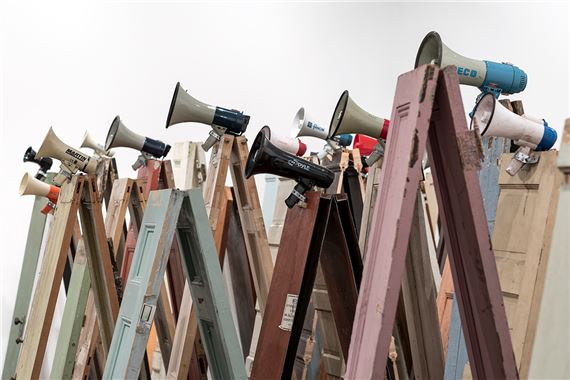
Recommended for you
Curated by MACBA director Elvira Dyangani Ose, along with Antawan Byrd, Adom Getachew and Matthew S. Witkovsky, Project a Black Planet: The Art and Culture of Panafrica is the first major international exhibition to examine the cultural manifestations of Pan-Africanism from the 1920s to the present.
It is a project developed jointly with the Art Institute of Chicago, the Barbican Centre in London and the KANAL–Centre Pompidou in Brussels. This collaboration has made the magnitude of the exhibition possible, with nearly 350 pieces by 100 artists touring the four institutions until spring 2027.
Although Pan-Africanism has been widely recognised as a major force in twentieth-century global history, until now there has been no major exhibition surveying this movement’s cultural manifestations. Project a Black Planet: The Art and Culture of Panafrica takes as its starting point the date of the first Pan-African Congress (1919) and revisits Pan-Africanism as a set of galvanizing ideas: projections of another vision of a world that have yet to be elucidated artistically or considered sufficiently relevant in political terms.
The exhibition addresses the art of the African diaspora as an aesthetics of back and forth, between the artistic production of the African continent and the proposals of Black communities scattered throughout the world. Artists, writers and other cultural workers have reacted over more than a century to global histories of supremacy, conflict and rupture, including slavery, colonialism and racial discrimination, among others.
While Pan-Africanism aspires to transnational and planetary solidarity, the exhibition also brings together experiences and manifestations conditioned by contextualised visions that are not always aligned. A broad set of philosophical ideas will structure the exhibition, while biographical information and a historical vision will be outlined by particular works, documents and installations.
MACBA proposes an itinerary structured around concepts that expand notions such as the foundations of Pan-Africanism, studies of negritude – both as an aesthetic movement and unifier of Blackness – representation, the weight of religious and animist beliefs, and the forms of public protest and anti-racism and civil rights movements.
The result is a collection of pieces in diverse materials and formats that, without hierarchy, represent fine arts, music and vernacular or popular cultures from Africa, Brazil, the Caribbean, North America and Western Europe. Visual and sound objects are also shown in dialogue with texts and political manifestos.
Throughout the exhibition, ephemera – from newspapers and magazines to posters and pamphlets – are of great relevance as they are crucial to understanding the importance of printed and graphic materials in the distribution and formation of Pan-Africanism. The curatorial team has pursued the painstaking task of researching relevant and groundbreaking materials on liberation in the catalogues of libraries and archives.
The exhibition is the result of ambitious research that is also manifested in an eponymous publication. This catalogue that endeavours to act as an academic reference for artistic research includes philosophical essays, biographical information and historical context related to the works and installations on display in the exhibition. Likewise, an academic anthology will compile contributions and a bibliography on the presence of Pan-Africanism in Spain at crucial moments in history. Similarly, this exhibition proposal is complemented by a rigorous public programme that provides the museum the opportunity to expand its audience and connect with new visitors. The programme will include public conversations, seminars, and outreach with local Black communities and archival activations, narrating not only the historical and global vision of Pan-Africanism but the oral traditions, diverse musical genres, political statements and environmental sounds of everyday life that have shaped the narrative of Pan-African unity and liberation in the Catalan, Spanish and European contexts.
Artists on show
- Abdias Nascimento
- Abdoulaye Ndoye
- Abdul Hadi El-Gazzar
- Adrian Piper
- Agnaldo Manoel dos Santos
- Ahmed Cherkaoui
- Alexander "Skunder" Boghossian
- Arthur Bispo do Rosário
- Atelier Populaire
- Azikiwe Mohammed
- Batoul SВ’himi
- Bertina Lopes
- Bruno Baptistelli
- Cauleen Smith
- Charmaine Spencer
- Chris Marker
- Chris Ofili
- Christopher Cozier
- Conceição Freitas Da Silva
- Cyprian Mpho Shilakoe
- Daniel Baker
- David Hammons
- David Koloane
- Dawit L. Petros
- Demas Nwoko
- Dread Scott
- Dumile Zwelidumile Mxgazi Feni-Mhlaba
- Ebony G. Patterson
- Edith Dekyndt
- Ernest Cole
- Ernest Mancoba
- Everlyn Nicodemus
- Fatma Arargi
- Frédéric Bruly Bouabré
- Gavin Jantjes
- Gazbia Sirry
- George Pemba
- George Rodger
- Gerard Sekoto
- Ghislain Cloquet
- Grace Ndiritu
- Groana Melendez
- Hale Woodruff
- Iba N`Diaye
- Ibrahim El Salahi
- Ilana Yacine Harris-Babou
- Ingrid Pollard
- Inji Efflatoun
- Irineu Destourelles
- James van der Zee
- Job Kekana
- Jürgen Schadeberg
- Kader Attia
- Kawira Mwirichia
- Kiluanji Kia Henda
- Kwame Brathwaite
- Larry Achiampong
- Lilian Mary Nabulime
- Liz Johnson Artur
- Lynette Yiadom-Boakye
- Magdalene Odundo
- Marilyn Nance
- Marlene Dumas
- Mel Edwards
- Moataz Nasr
- Monica De Miranda
- Mwangi Hutter
- Nicholas Hlobo
- Njideka Akunyili Crosby
- Olu Oguibe
- Omar El Nagdi
- Otobong Nkanga
- Precious Okoyomon
- Rasheed Araeen
- Reinata Sadimba Passema
- René Zuber
- Rosana Paulino
- Rotimi Fani-Kayode
- Sabelo Mlangeni
- Samir Rafi
- Sammy Baloji
- Samuel Fosso
- Seyni Awa Camara
- Simone Leigh
- Sonia Gomes
- Tavares Strachan
- The Otolith Group
- Theaster Gates Jr.
- Ubirajara Ferreira Braga
- Valerie Desmore
- Wifredo Lam
- Yná Kabe Rodríguez Olfenza
- Yonamine
- Yto Barrada
- Zanele Muholi

 ARTISTS
ARTISTS







